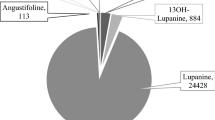Abstract
Lupinus leucophyllus is one of many lupine species known to contain toxic and/or teratogenic alkaloids that can cause congenital birth defects. The concentrations of total alkaloids and the individual major alkaloids were measured in three different years from different plant parts over the phenological development of the plant. All of the alkaloids were found in the different plant tissues throughout the growing season, although their levels varied in different tissues. Concentrations of total alkaloids and the individual alkaloids varied on an annual basis and in their distribution in the different tissues. Anagyrine levels were highest in the floral tissue, lupanine and unknown F accumulated to the greatest level in the vegetative tissue, and 5,6-dehydrolupanine accumulated to the highest level in the stem. These alkaloids appear to be in a metabolically active state with the teratogenic alkaloid anagyrine accumulating to its highest level in the developing seed. The latter is, thus, the phenological stage posing the greatest danger to grazing livestock.





Similar content being viewed by others
References
Bagley, C. and Panter, K. E. 1996. Lupine poisoning: crooked calf disease. Western Beef Producer, April 1996, p. 6–7.
Binns, W., James, L. F., Shupe, J. L., and Beeson, K. C. 1962. Crooked calf disease produced experimentally. Utah Farm Home Sci. 23:35–47.
Cho, Y. D. and Martin, R. O. 1971. Biosynthesis of Thermopsis alkaloids from carbon-14 dioxide. Evidence for the formation of the pyridine bases from lupanine via 5,6-dehydrolupanine. Can. J. Biochem. 49:971–977.
Gardner, D. R. and Panter, K. E. 1993. Comparison of blood plasma alkaloid levels in cattle, sheep, and goats fed Lupinus caudatus. Ammodendrine and related piperidine alkaloid levels in the blood plasma of cattle, sheep and goats fed Lupinus formosus. J. Nat. Toxins 2:1–11.
Keeler, R. F. 1976. Lupin alkaloids from teratogenic and nonteratogenic lupins. III. Identification of anagyrine as the probable teratogen by feeding trials. J. Toxicol. Environ. Health 1:878–889.
Keeler, R. F. and Panter, K. E. 1989. Piperidine alkaloid composition and relation to crooked calf disease-inducing potential of Lupinus formosus. Teratology 40:423–432.
Kingsbury, J. M. 1964. Poisonous Plants of the United States and Canada. Prentice-Hall, Englewood Cliffs, NJ.
Kinghorn, A. D. and Balandrin, M. F. 1983. Quinolizidine alkaloids of the Leguminosae: Structural types, analysis, chemotaxonomy, and biological activities, in S. W. Pelletier (ed.). Alkaloids: Chemical and Biological Perspectives, Vol. 1. Wiley, New York, NY.
Koricheva, J. 1999. Interpreting phenotypic variation in plant allelochemistry: Problems with the use of concentrations. Oecologia 119:467–473.
Panter, K. E., Bunch, T. D., Keeler, R. F., Sisson, D. V., and Callan, R. J. 1990. Multiple congenital contractures (MCC) and cleft palate induced in goats by ingestion of piperidine alkaloid-containing plants: Reduction in fetal movement as the probable cause. Clin. Toxicol. 28:69–83.
Panter, K. E., Gardner, D. R., Gay, C. C., James, L. F., Mills, R., Gay, J. M., and Baldwin, T. J. 1997. Observations of Lupinus sulphureus-induced crooked calf disease. J. Range Manag. 50:587–592.
Panter, K. E., Gardner, D. R., and Molyneux, R. J. 1998. Teratogenic and fetotoxic effects of two piperidine alkaloid-containing lupines (L. formosus and L. arbustus) in cows. J. Nat. Toxins 7:131–140.
Ralphs, M. H., Panter, K. E., Gay, C., Motterram, E., and Lee, S. T. 2006. Cattle consumption of velvet lupine (Lupinus leucophyllus Dougl.) in the channel scablands of Eastern Washington. Rangeland Ecology & Management 59:204–207.
SAS 1999. Statistical Analysis Systems, V8e. SAS, Cary, N.C.
Shupe, J. L., James, L. F., and Binns, W. 1967a. Observations on crooked calf disease. J. Am. Vet. Med. Assoc. 151:191–197.
Shupe, J. L., Binns, W., James, L. F., and Keeler, R. F. 1967b. Lupine, a cause of crooked calf disease. J. Am. Vet. Med. Assoc. 151:198–203.
Warnock, D. 1997. Lupine toxicity. Western Beef Producer, May 1997, p. 20–22.
Wink, M. and Hartmann, T. 1981. Sites of enzymatic synthesis of quinolizidine alkaloids and their accumulation in Lupinus polyphyllus. A. Pflanzenphysiology 102:337–344.
Wink, M., Meibner, C., and Witte, L. 1995. Patterns of quinolizidine alkaloids in 56 species of the genus Lupinus. Phytochemistry 38:139–153.
Wink, M. and Witte, L. 1984. Turnover and transport of quinolizidine alkaloids. Diurnal fluctuations of lupanine in the phloem sap, leaves and fruits of Lupinus albus L. Planta 161:519–524.
Author information
Authors and Affiliations
Corresponding author
Rights and permissions
About this article
Cite this article
Lee, S.T., Ralphs, M.H., Panter, K.E. et al. Alkaloid Profiles, Concentration, and Pools in Velvet Lupine (Lupinus leucophyllus) Over the Growing Season. J Chem Ecol 33, 75–84 (2007). https://doi.org/10.1007/s10886-006-9211-z
Received:
Accepted:
Published:
Issue Date:
DOI: https://doi.org/10.1007/s10886-006-9211-z




